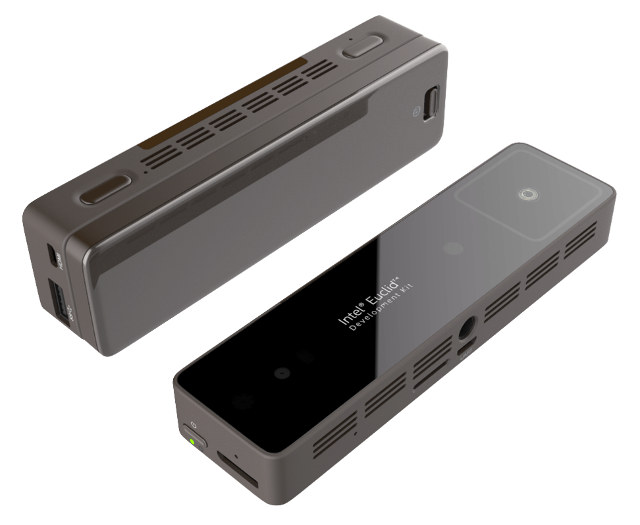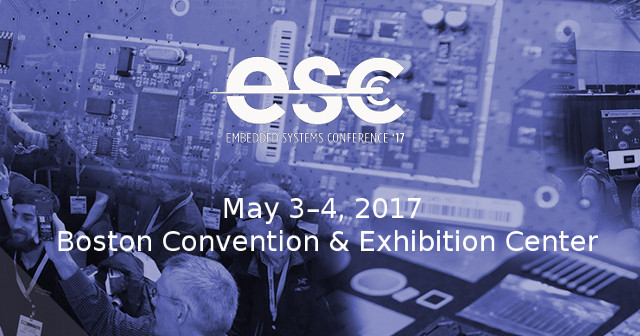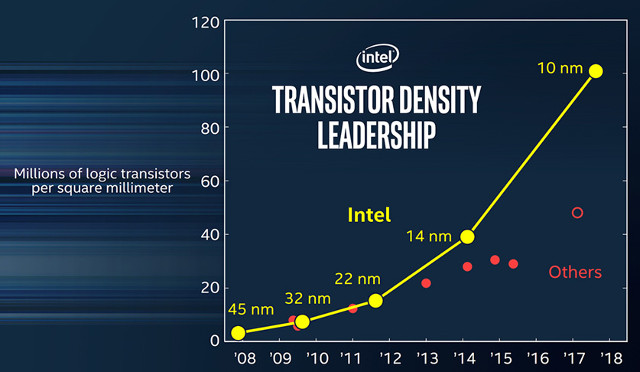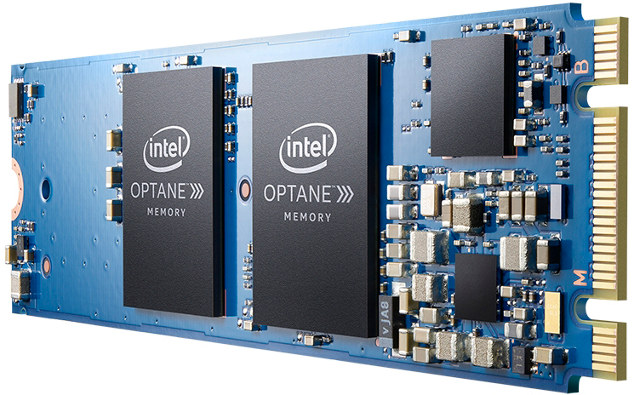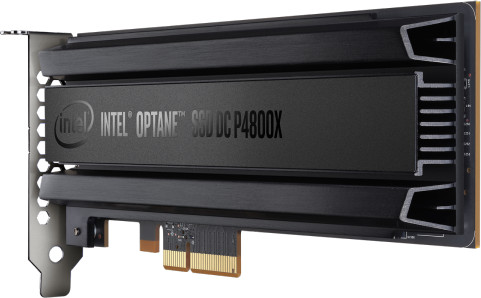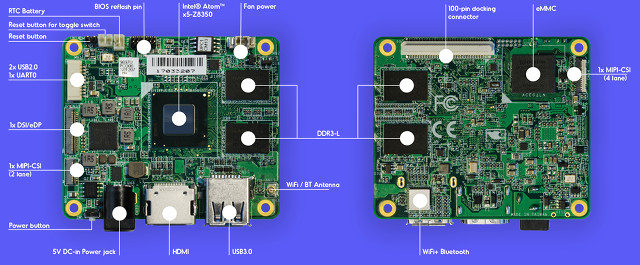Google has been working on supporting Android apps and the Play Store on Chromebooks, which are normally sold with either ARM or Intel processors. So the ability to run Android apps well is one of the things to consider before purchasing a Chromebook. Shrout Research has published a paper entitled “Chromebook Platform Choice Important for Android App Performance” comparing an Acer Chromebook R13 with a Mediatek MT8173C ARM Cortex A72/A53 processor to Acer Chromebook R11 with an Intel Celeron N3060. The Intel Chromebook has a smaller resolution so this could be an advantage, so less resources are needed to update the display. However, the ARM processor is significantly more powerful than the Intel one according to GeekBench results, and Chromebook R13 is sold for $399 on Amazon US, while Chromebook R11 goes for $299 (and lower during promotions). So it’s not a perfect comparison, but it should give an idea […]
$399 Intel Euclid Robotics Devkit Runs Ubuntu & ROS on Intel Atom x7-Z8700 Processor
We’ve seen many mini PC based on Intel Atom x5/x7 “Cherry Trail” processor in the last year, but Intel has also integrated their low power processor into hardware aimed at robotics, such as Intel RealSense development kit based on Atom x5 UP Board and RealSense R200 depth camera. The company has now launched its one-in-all Intel Euclid development kit combining Atom X7-Z8700 processor with a RealSense camera in a single enclosure. Intel Euclid specifications: SoC – Intel Atom x7-Z8700 Cherry Trail quad core processor @ up to 2.4GHz with Intel HD Graphics Gen 8 System Memory – 4GB LPDDR3-1600 Storage – 32GB eMMC 5.0 flash, Micro SD slot up to 128GB Video Output – micro HDMI port up to 4K @ 30 Hz Audio – 2x I2S interfaces, 1W mono speaker, 3x DMIC with noise cancellation Camera – Intel RealSense ZR300 camera RGB camera – 2MP up to 1080p@30fps, 16:9 […]
Embedded Systems Conference 2017 Schedule – May 3-4
The Embedded Systems Conference 2017 will take place over two days in Boston, US on May 3-4, and the organizers have published the schedule of the event. Even if you’re not going to attend, you’ll often learn something or find new information by just checking out the talks and abstracts, so I’ve created my own virtual schedule with some of the most interesting sessions. Wednesday, May 3rd 08:00 – 08:45 – Combining OpenCV and High Level Synthesis to Accelerate your FPGA / SoC EV Application by Adam Taylor, Adiuvo Engineering & Training Ltd This session will demonstrate how you can combine commonly used Open source frameworks such as OpenCV with High Level Synthesis to generate a embedded vision system using FPGA / SoC. The combination of OpenCV and HLS allows for a much faster algorithm development time and consequently a faster time to market for the end application. 09:00 – 09:45 […]
Intel: My 10nm Process is Denser Than Yours
Process technology is important as the lower the process node, the more efficient the processor becomes, which leads to either longer battery life for the same tasks on battery powered devices, or allows for higher frequencies extracting more performance. Qualcomm and Samsung recently announced Snapdragon 835 SoC was manufactured using 10nm process technology, but Mark Bohr, an Intel Senior Fellow and director of process architecture and integration at Intel Corporation. wrote a blog post explaining that while in the past process node size and density were progressing in a “linear” fashion, this is not the case anymore, as marketing has changed, and some companies advance node names, even in cases where there’s minimal or no density increase. The chart above implies that some companies 10nm process is barely better than Intel’s 14 nm process, with their 10nm process capable of integrating about twice as much transistors per square millimeter compare […]
isorespin.sh Script Updates Ubuntu ISO Files with Mainline Linux Kernel
Devices based on Intel Bay Trail and Cherry Trail processors have been popular due to their integration into low cost system (for an Intel platform), but Intel did not prioritize Linux development for those processors, so while Linux could run, you’d have various problems with HDMI audio, system freezes, and wireless drivers, unless you used a custom kernel. The goods news is that Linux 4.11 will feature fixes for HDMI audio and system freeze, and so you won’t need a custom kernel anymore. Ian Morrison (Linuxium), who has been working on improving Linux for those devices since they were first released, has now released isorespin.sh script to automatically update any Ubuntu ISO image to the latest mainline Linux RC kernel built by Canonical, but not integrated by default in the ISO. Once you’ve downloaded isorepin.sh and your ISO of choice, e.g. ubuntu-16.04.2-desktop-amd64.iso, you can update the ISO with mainline Linux […]
Intel to Launch Optane Memory M.2 Cards for Desktop PCs Next Month for $44 and Up
Intel launched their first Optane SSD based on 3D Xpoint technology for the enterprise/datacenter market last week, and now the company has announced 16GB and 32GB consumer grade Optane memory will start selling in April starting at $44. The cards will follow M.2 card (80mm) form factor, use a dual PCIe NVMe 3.0 interface, and currently only works with Optane compatible motherboards with 7th generation Intel Core processors. Intel promises boot times that are twice as fast, 28% better overall performance, and 65% faster game level loads thanks to vastly improved random I/O performance. We can see some of the specs for both cards on Intel website. I reproduced some of the performance reliability data in the table below. 32GB Optane Memory 16GB Optane Memory Sequential Read (up to) Up to 1350 MB/s Up to 900 MB/s Sequential Write (up to) Up to 290 MB/s Up to 145 MB/s Random […]
Intel Optane SSD DC P4800X is the First SSD based on 3D Xpoint Technology
3D Xpoint – pronounced “3D cross point” – was introduced in 2015 with the promise of delivering a 1000 times boost in performance and durability compared to NAND flash, and a density that 10 times better than DRAM. The next year, expectations were lowered quite a bit, when Intel presented a comparison between a high performance “NAND” SSD and a 3X point SSD prototype showing 7.23 times higher IOPS performance. The company has now launched its first 3D Xpoint product with Optane SSD DC P4800X with 375GB capacity. Optane SSD DC P4800X specifications: Capacity – 375GB Interface – PCIe 3.0 x4, NVMe Form Factor – Add-in-Card (AIC); Half-height, Half-length, Low-profile Latency (typical) R/W – <10μs Quality of Service (QoS) 99.999% 4kB 5 Random Queue Depth 1, R/W: <60/100 μs 4kB Random Queue Depth 16, R/W: <150/200 μs Throughput IOPS Random 4kB R/W – Up to 550/500k IOPS Random 4kB 70/30 […]
UP Core is a Low Cost & Compact Intel Maker Board Powered by an Atom x5-Z8350 SoC (Crowdfunding)
The UP community has already launched Intel Cherry Trail and Apollo Lake boards in the past with UP Board and UP2 (squared) boards, and they are now about to launch a cheaper and smaller board called UP Core powered by Intel Atom x5-Z8350 processor with to 1 to 4GB memory, up to 64GB eMMC flash, HDMI, USB 3.0, … and I/O expansion connectors. UP Core specifications: SoC – Intel Atom x5-Z8350 “Cherry Trail” quad core processor @ 1.44 GHz / 1.92 GHz (Burst frequency) with Intel HD 400 graphics @ 200 / 500 MHz System Memory – 1, 2 or 4 GB DDR3L-1600 (soldered on board) Storage – 16, 32, or 64 GB eMMC flash, SPI flash ROM Video Output / Display – HDMI 1.4 port, full eDP (embedded DisplayPort) connector Audio I/O – Via HDMI, and I2S Connectivity – 802.11 b/g/n WiFi @ 2.4 GHz, Bluetooth 4.0 LE (AP614A) […]



